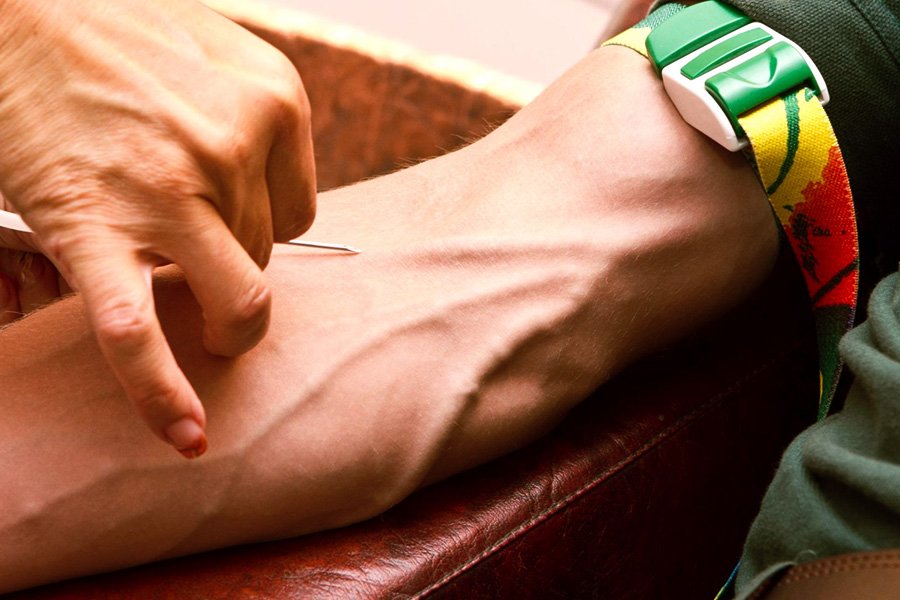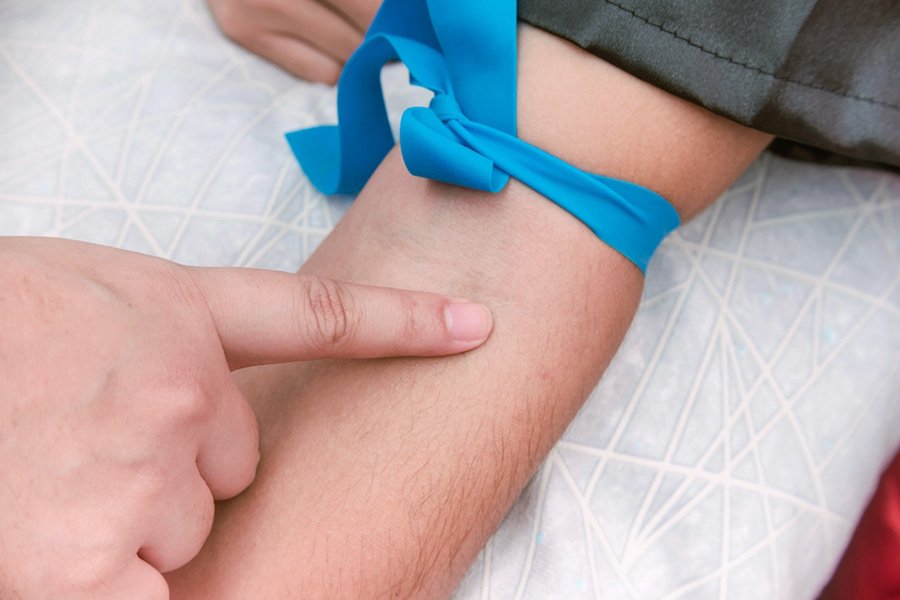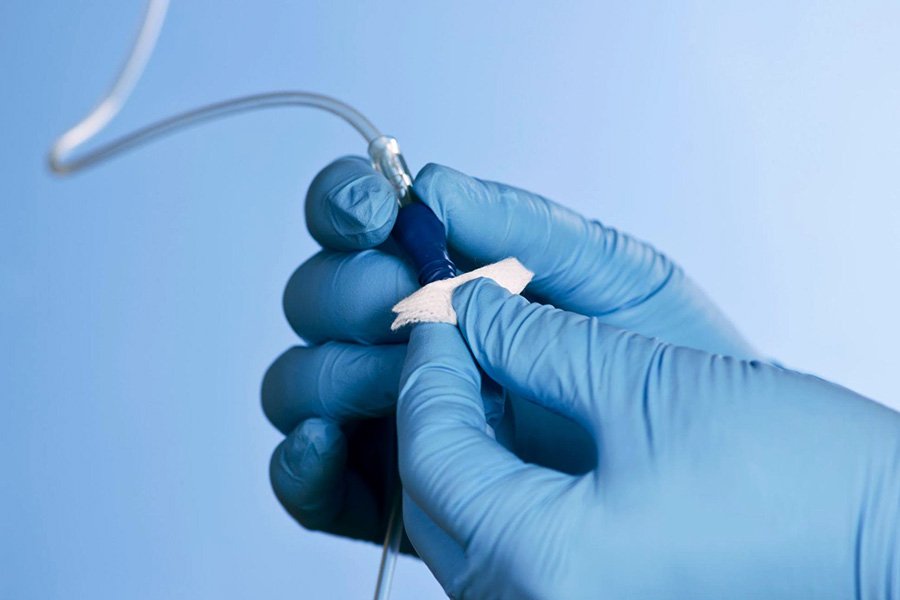Peripheral intravenous lines are a common medical intervention used to administer fluids, medications, blood products, or nutrients directly into a patient’s bloodstream. Selection of peripheral IV sites is a task that demands a keen understanding of a list of factors concerned with the patient’s medical history and current condition.
This article examines the different factors involved in site selection, explaining the types of IV catheters, insertion techniques, and more. It investigates the importance of peripheral IV maintenance and offers insight into the benefits and risky areas associated with peripheral IV placements.

Source: shutterstock.com/ Photo Contributor: viicha
Site Selection and Preparation
Selecting the right site for peripheral IV lines is a process that depends on careful evaluation of the patient’s anatomy and medical history. When doing so, keeping some common considerations in mind is key in ensuring a safe and effective delivery.
Peripheral IV access considerations
Each patient has a unique situation and a prescribed therapy involved. Still, some general recommendations can help medical professionals identify which peripheral IV insertion sites make the most suitable choice.
Potentially risky areas
One of the most worthy mentions when discussing IV insertion is that any site that causes pain palpation is deemed unsuitable. The ventral surface of the wrist is mainly avoided due to the risk of nerve damage and potential pain involved.
Compromised sites
Areas with compromised vascular integrity should also be avoided. Such areas include engorged veins, open wounds, infections, bruised areas, and sites with previous infiltration.
Past medical interventions
Medical history plays an integral role when choosing an insertion site, as veins in the upper extremity may be affected by certain procedures. For instance, it is best to avoid upper body veins on the side where breast surgery was performed. Unique considerations also apply to patients who have undergone radiation therapy and individuals suffering from lymphedema.
It’s worth noting that patients with a rich medical history might have a higher risk involved. Discussing the situation with a medical practitioner familiar with their conditions can help weigh the benefits and risks of using a certain vein.
Chronic kidney disease considerations
Maintaining the health of the peripheral veins is extremely important in patients suffering from kidney disease. Venipuncture in peripheral veins within the upper extremities may compromise their condition and cause problems in future vascular access.
Factors affecting site selection for peripheral IV access
Several factors may influence the choice of peripheral vascular access. Some of the most important elements in the selection process include the following.
Patient’s condition
The first factor that licensed professionals should consider is the patient’s overall health status. Chronic or acute conditions usually dictate specific requirements. For example, certain areas might be contraindicated due to a specific type of medical diagnosis. Some health conditions, such as diabetes, are known to undermine the quality of the veins and may significantly impact the choice of site.
Age
The tolerance of IV insertion is determined by vein condition, which is largely affected by age. Elderly patients are more likely to have fragile veins, and these patients usually require a more careful site selection. Some common practices in elderly patients include using a tourniquet made from a softer material and applying it lightly to avoid vein pressure and vein blows.
Skin condition
Site selection is also determined based on the integrity and condition of the skin in the desired area. For instance, infections and dermatological conditions such as edema will likely strongly impact the site selection process.
Type and duration of IV therapy
The type of therapy and its duration are perhaps some of the most critical elements in choosing a target point for a peripheral IV line. A licensed medical professional determines both the duration and type of therapy. Individuals interested in IV therapy can learn more about the process at Drip Hydration Phoenix.
Indications for Peripheral IV Access
Peripheral intravenous (IV) catheter placement is a cornerstone of modern medicine, offering significant benefits for patient care. These catheters facilitate a wide array of essential medical treatments and diagnostic procedures.
Benefits of peripheral IV access over other methods
Peripheral IV access provides a reliable, flexible, and relatively safe method for medication administration, rehydration, and blood sampling. Here is how it compares to other methods, such as central venous catheter placement.
Safety and ease of placement
Peripheral IV lines are generally safer and easier to place than a peripherally inserted central catheter. Central venous catheter placement involves accessing the large veins in the chest and is mainly reserved for long-term treatments.
In contrast, peripheral intravenous line placements are short-term and generally less invasive, which may reduce the risk of complications. A recent study on peripheral venous access in adults indicates that the success rate of first-time placements in peripheral IV lines is between 65% to 86%.
Reduced pain and discomfort
Since the venous catheters are placed in the neck or chest, they come with increased patient discomfort. Contrarily, peripheral catheter placements are the inner elbow, back of the hand, and foot. These allow patients greater mobility and offer greater overall comfort.

Source: shutterstock.com/ Photo Contributor: Numstocker
When peripheral IV access may not be appropriate
In certain clinical situations, peripheral IV access may pose challenges or might not be the optimal choice for venous access. Understanding these scenarios is crucial for healthcare professionals to make informed decisions about patient care.
Several factors can contribute to difficulty in placing a peripheral IV or may indicate the need for an alternative method of venous access.
History of difficult placement
Although peripheral IV therapy has a relatively high success rate, some studies suggest that peripheral IV catheter failures have a failure rate of 36%. This suggests that standard peripheral access might be harder in some patients. This means individuals who have a history of difficulty with peripheral IV placements will require careful consideration.
Non-visible or very small veins
Patients with non-visible or small veins, including those with certain medical conditions, may require alternative access methods, as peripheral IV placement can be technically challenging.
History of nonmedical intravenous drug use
Accessing addict patient IV sites can often be difficult, if not impossible. One of the main reasons for this is that a history of drug abuse often results in scarred or collapsed veins. These patients are a high-risk factor as reports suggest they often try to manipulate their IV lines, which can potentially lead to contamination.
Health problems
Conditions such as diabetes and skin cell disease may affect the vasculature, making peripheral vascular access less suitable. The veins in obese patients can also be deeper and harder to access as they are less visible. Difficulty accessing veins peripherally is also likely in patients undergoing chemotherapy.
Types and Sizes of Peripheral IV Catheters
Various peripheral IV catheter types
Understanding the types of peripheral IV catheters available is crucial for effective treatment and helps maximize patient comfort. Generally, peripheral IV catheters fall under three categories:
Short peripheral intravenous catheters (short PIVCs)
Long peripheral intravenous catheters (long PIVCs)
Midline catheters
Short peripheral intravenous catheters (SPIVCs)
These over-the-needle catheters feature a hollow metal needle (stylet), which is usually inserted in superficial veins. Due to their smaller design, SPIVCs are mainly used in short-term IV therapy, which doesn’t last longer than six days. They are particularly useful for short-term medication and hydration.
Short peripheral catheters have a straightforward insertion process, which makes them a popular choice in the IV infusion community.
Long peripheral intravenous catheters (LPIVCs)
Long peripheral catheters are predominantly used as an alternative when short SPIVCs are insufficient. These catheters can be inserted into either superficial or deep peripheral veins, offering great versatility.
LPIVCs’ extended length makes them an appropriate choice for patients requiring deeper, more secure venous access. They can be administered using the advanced Seldinger technique and may also be introduced through the traditional over-the-needle technique.
Midline catheters
Midline catheters represent a unique category in peripheral IV access. They are typically used for therapies lasting up to several weeks as they remain in place longer than short PIVCs.
They are less invasive than central venous catheters and can be administered through various peripheral IV sites. Typically, they are inserted in the peripheral vein of the upper arm but may also be inserted via the scalp vein and in the lower extremity.
Gauge and diameter considerations
In peripheral IV lines, gauge size is a critical factor. Simply put, the gauge size is used to describe the diameter of the catheter. The diameter is measured using the French or Birmingham gauge systems. It’s important to note that lower numbers signify a larger diameter within the gauge system.
Peripheral catheters are usually available in sizes ranging from 14 to 26. The 14 gauge size, being the largest, allows for higher potential flow rates. Such catheters are mainly used for rapid fluid administration and are considered most adequate for emergency situations.
In contrast, higher gauge sizes, which are more narrow, are typically used for slower infusions. Medical professionals tend to use these in patients with smaller, more fragile veins.
Insertion Technique
While looking into peripheral IV insertion sites, it’s essential to emphasize the use of proper technique. While finding a good insertion target in patients is important, paying attention to details within the insertion process should be a priority.
Providing a detailed overview of specific techniques used for each IV site is a complex and lengthy process. However, there are some basic concepts to keep in mind in all these procedures.

Source: shutterstock.com/ Photo Contributor: MDV Edwards
The basics of inserting a peripheral IV catheter
While administering IV can seem simplistic compared to other more advanced medical setups, taking the time to ensure proper patient positioning is preferable. Preparation is a critical aspect of any IV technique.
First, the nurse or medical professional should ensure all the equipment is available and ready for one-hand use. The essential supplies list usually includes a tourniquet, alcohol swabs, an IV catheter, IV tubing, tape, and gauze.
The next step includes finding a suitable IV insertion point. According to some general recommendations, avoiding the wrist’s flexor portion and other areas prone to obstruction is best. Choosing a vein segment that is clearly visible or palpable usually brings the best results.
After identifying an entry point, medical personnel usually take their time to warm the area and increase blood flow. Applying the tourniquet in close proximity to the insertion area (1 to 3 inches) is preferable. The tourniquet should be wrapped tightly, but it shouldn’t cause major discomfort for the patients.
The aim of the tourniquet is to cause the veins to engorge with blood and make them easier to identify, which in turn eases catheter insertion. Once the medical operator finds a suitable entry point, they clean the area with antiseptic and insert the needle.
Best practices for ensuring successful insertion
Proper hygiene is critical within every IV administration. To minimize the risk of potential contamination, medical professionals should always clean the insertion site using an alcohol swab.
Anchoring the selected vein is another critical aspect of a successful insertion. This is done by securing the limb to minimize patient movement. Applying moderate pressure below the insertion site should be standard practice as this may help prevent vein rolling.
Holding the catheter with a pinchin grip is preferable for proper insertion. Usually, it is inserted at a shallow angle; however, the angle is determined based on the insertion site. For instance, a sharper angle usually works best when standing on top of a vein, while a shallow angle is more suitable when starting distal to a vein.
Once the IV tubing or valve has been attached, tapping up the catheter is advisable. The tape works as a barrier and prevents the catheter from pulling out. However, it should be easily removable if quick access to the catheter is required.
Common insertion challenges
While IV insertion is generally safe, failure to administer a catheter properly may result in some unwanted effects. One of the most common challenges surrounding this process is IV infiltration.
IV infiltration occurs when the tip of the catheter slips out of the vein, causing fluid to leak out under the skin. Some common side effects of infiltration include pain, swelling, and burning in the area. These symptoms call for an immediate catheter removal. This is why monitoring patients and checking in for any potential side effects after administering the catheter should be standard practice.
Overall, no matter the technique used, IV insertion calls for gentle manipulation, as neglect and rushing through the process may easily result in issues such as inflammation and infiltration.
Maintenance of Peripheral IV Sites
Monitoring and maintaining a peripheral IV involves regular assessments. It includes hourly checks of the infusion site for complications, reviewing cumulative volume, and adjusting infusion pump pressure as needed. Additionally, PIVC dressing and cannula securement are among the most critical aspects of IV maintenance.
As dressing is the first line of defense against infections, regular chances are of high significance. Dressing changes require careful inspection for infection signs and are best to change daily in long-term therapy.
Potential complications and how to address them
Peripheral IV catheters (PIVCs) can encounter several complications that require immediate attention. Infection is a primary concern, with skin-based bacteria potentially entering through the insertion site, leading to local cellulitis or systemic bacteremia.
Phlebitis, or vein irritation, is another complication caused by the catheter, fluids, or medications, particularly in patients requiring frequent IV access.
Other issues include infiltration, extravasation, occlusion, dislodgement, and catheter migration. Management of these complications involves careful monitoring, prompt recognition, and appropriate intervention.
For instance, in cases of suspected infection, the PIVC should be removed, and the site should be treated according to the severity of the infection. For phlebitis, removing the catheter and applying warm compresses may alleviate symptoms.
Strategies for preventing complications
Prevention strategies for PIVC-related complications emphasize adherence to aseptic techniques during both insertion and maintenance. Regular assessments of the device are crucial to identify early signs of complications.
Hand hygiene before and after handling the PIVC and using non-sterile gloves during its removal are essential to prevent infection. The catheter should be removed as soon as medically feasible to minimize risks.
When removing the PIVC, it’s important to gently withdraw the catheter while holding a sterile gauze or cotton wool over the exit site without applying pressure and then covering the site with a dressing.
Educating patients and caregivers about signs of complications and post-removal care is also vital in prevention. This is why caregivers are instructed to discuss the IV insertion procedure with patients both before and after placing the catheter. Their duty lies not only in inserting the IV correctly and safely but also in patient care.
It’s a good practice to inform patients of the possible risk that movement might cause in some peripheral insertion sites. Talking about the symptoms of an allergic reaction or informing the patient about possible complications can be helpful, but it really depends on the patient’s situation.

Source: shutterstock.com/ Photo Contributor: MedstockPhotos
Conclusion
Selecting an optimal peripheral IV site requires a nuanced understanding of patient anatomy, medical history, and the specific demands of the prescribed therapy. Avoiding risky areas, keeping in mind factors such as past medical interventions and patient history, and considering unique medical conditions such as chronic kidney disease is essential.
Additional factors such as the patient’s age, skin condition, and type and duration of peripheral IV therapy also play a significant role in choosing peripheral IV sites.
While peripheral IV access offers numerous benefits, it’s important to recognize situations where it might not be appropriate. Ultimately, the successful placement and maintenance of a peripheral IV line demands proper insertion technique and ongoing vigilance to prevent possible complications.




